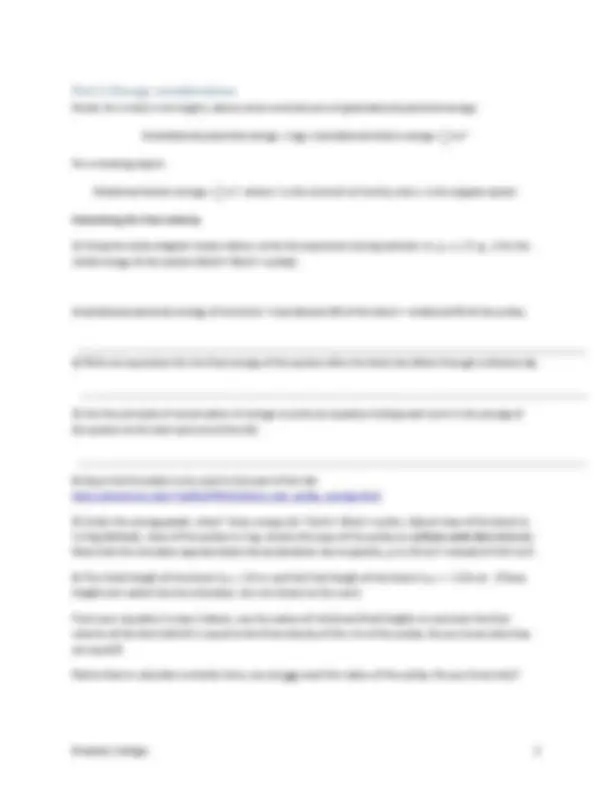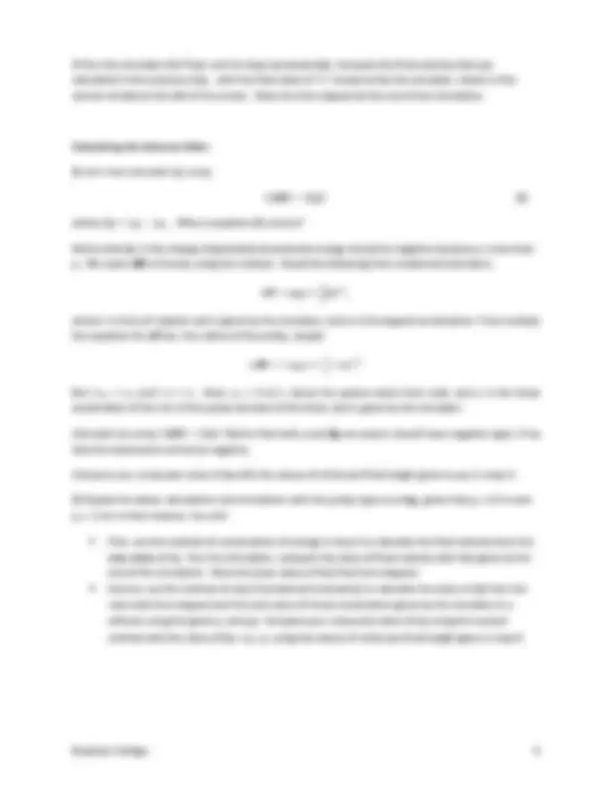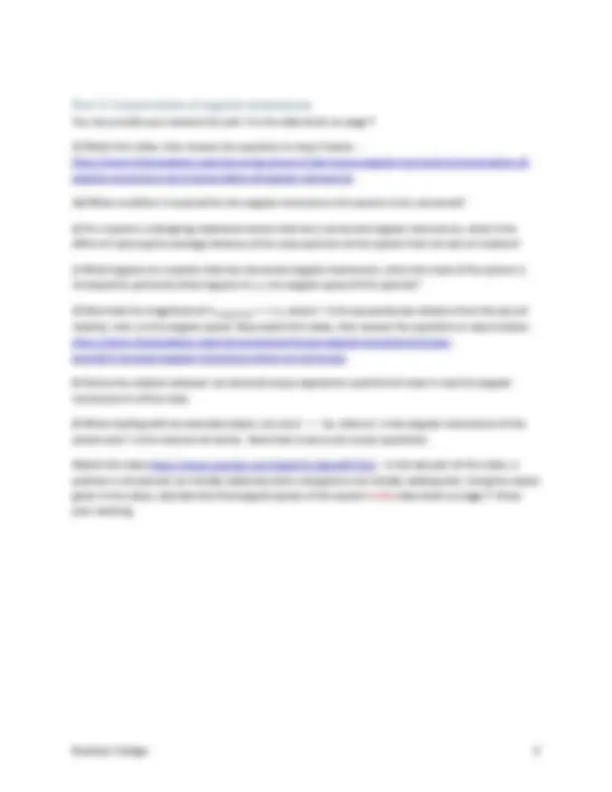





Study with the several resources on Docsity

Earn points by helping other students or get them with a premium plan


Prepare for your exams
Study with the several resources on Docsity

Earn points to download
Earn points by helping other students or get them with a premium plan
Community
Ask the community for help and clear up your study doubts
Discover the best universities in your country according to Docsity users
Free resources
Download our free guides on studying techniques, anxiety management strategies, and thesis advice from Docsity tutors
Simulation of rotational dynamics, rotational inertia and conservation of angular momentum
Typology: Lab Reports
1 / 7

This page cannot be seen from the preview
Don't miss anything!




This online lab exercise will allow you to simulate several experiments in rotational motion. In the first
two parts, hanging masses will be allowed to fall, and you will calculate their final velocities and
compare them with the values presented by the simulators.
The two different simulators used in Part 1 and Part 2 allows you to change the type of pulley, and
therefore its moment of inertia. In Part 3, you will explore the concept of angular momentum through
two videos including a video experiment. You will apply the conservation of angular moment to a
system comprising two disks which undergo an inelastic collision, in order to find the final angular
velocity of the system.
Angular momentum is a vector denoted by 𝑳. For a point object of mass 𝑚, the magnitude of the
angular momentum, 𝑳, is given by
𝐿 = 𝑟 𝑝 sin 𝜃 = 𝑟
,
,
where 𝑟 ,
is the perpendicular distance from the point about which angular momentum is computed to
the direction of p , the linear momentum of the particle object. Similarly 𝑝 ,
is the component of the
linear momentum that is perpendicular to 𝒓. In this description, 𝒓 is the radial vector from the axis
about which angular momentum is computed to the particle.
For an extended object, 𝑳 = 𝐼𝝎, where 𝐼 is the moment of inertia of the extended object or system,
and 𝝎 is the angular velocity. Note that for a point object you can still use 𝑳 = 𝐼𝝎, and since I for a
point object 𝐼 = 𝑚𝑟
0
, and 𝑣 = 𝑟𝜔, we recover L = r ꓕ
p or rp ꓕ
This lab runs in any web browser. The simulation tools used are:
Part 1: https://ophysics.com/r5.html
Part 2: http://physics.bu.edu/~duffy/HTML5/block_and_pulley_energy.html
Part 3: 3 separate videos, links given below in the text.
For the diagram shown, the hanging mass is allowed to fall, thus pulling on the string and rotating the
pulley.
Newton’s second law: Net Torque = 𝐼 𝛼 , where 𝐼 is the moment of inertia, and α is the angular
acceleration. Using the two equations, derive a formula for the angular acceleration of the pulley in
terms of 𝐼 , 𝑚 and 𝑟 (and 𝑔). To get you started, note that:
force, 𝑚𝑔 generates a torque of 𝑚𝑔𝑟 on the pulley, about an axis running through its
middle.
acceleration of the rim of the pulley.
can be written in terms of the angular acceleration as follows: 𝑎 = 𝑟 𝛼.
different expressions for the moment of inertia, 𝐼 of the pulley. Those expression for 𝐼
are given below.
2 ) Open the simulator: https://ophysics.com/r5.html
In the simulation type, select falling mass, and in mass
distribution select solid cylinder. The moment of inertia
of a solid cylinder of mass M, radius r about an axis that
runs perpendicular to the cylindrical face, though its
center, is
6
0
0
and the mass of the pulley, 𝑀 to 5 kg, and the radius of
the pulley, 𝑟 to 0.5 m. Notice that we are using the
pulley as a solid cylinder. Click start and wait till 𝛼 and 𝑎
become displayed then click pause.
a of the rim of the pulley and of pulling mass 𝑚. Compare to the measured values given by the
simulator.
6 ) Repeat the above steps for the pulley as a solid sphere. The moment of inertia of a solid cylinder of
mass M, radius r about an axis through its center is:
0
;
0
After you complete the above for both a solid cylinder pulley and a solid sphere pulley, go to the next
part of the lab: Part 2, Energy considerations.
m,
pulling
mass
M, mass
of pulley
calculated in the previous step. with the final value of “v” measured by the simulator, shown in the
column of data to the left of the screen. Note the time elapsed at the end of the simulation.
Calculating the distance fallen
8 ) Let’s next calculate ∆𝒚 using
where ∆𝒚 = 𝒚 𝟐
𝟏
. Why is equation (2) correct?
Notice that ∆y in the change of gravitational potential energy should be negative because y 2
is less than
y 1
. We need r ∆ q to find Dy using this method. Recall the following from rotational kinematics:
𝟎
𝟏
𝟐
0
where 𝑡 is time of rotation and is given by the simulator, and α is the angular acceleration. If we multiply
the equation for 𝜟𝜽 by r the radius of the pulley, we get:
𝒐
6
0
0
But 𝑟𝜔 I
I
𝑎𝑛𝑑 𝑟 𝛼 = 𝑎. Here, 𝑣
I
= 0 𝑚/𝑠, (since the system starts from rest), and 𝑎 is the linear
acceleration of the rim of the pulley and also of the block, and is given by the simulator.
Calculate ∆𝒚 using 𝑟
. Notice that both a and D y as vectors should have negative signs, if we
take the downward vertical as negative.
Compare your computed value of ∆y with the values of initial and final height given to you in step 6.
9 ) Repeat the above calculations and simulation with the pulley type as a ring , given that y 1
= 2.4 m and
y 2
= - 1 cm in that instance. You will:
new value of Dy. Run the simulation, compare the value of final velocity with that given at the
end of the simulation. Note the (new value of the) final time elapsed.
new total time elapsed and the new value of linear acceleration given by the simulator (i.e.
without using the given y 1
and y 2
). Compare your computed value of Dy using this second
method with the value of Dy = y 2
using the values of initial and final height given in step 9.
You can provide your answers for part 3 in the data sheet on page 7
https://www.khanacademy.org/science/ap-physics-1/ap-torque-angular-momentum/conservation-of-
angular-momentum-ap/v/conservation-of-angular-momentum
2 a) What condition is required for the angular momentum of a system to be conserved?
b) For a system undergoing rotational motion that has a conserved angular momentum, what is the
effect of reducing the average distance of the mass particles of the system from the axis of rotation?
c) What happens to a system that has conserved angular momentum, when the mass of the system is
increased (in particular what happens to 𝜔, the angular speed of the system)?
= 𝑟𝜔, where 𝑟 is the perpendicular distance from the axis of
rotation, and 𝜔is the angular speed. Now watch this video, then answer the questions in step 4 below:
https://www.khanacademy.org/science/physics/torque-angular-momentum/torque-
tutorial/v/constant-angular-momentum-when-no-net-torque
momentum 𝑳 of the mass.
system and 𝐼 is the moment of inertia. Note that 𝑳 and 𝝎 are vector quantities.
Watch this video https://www.youtube.com/watch?v=hgcudPr73LU. In the last part of this video, a
problem is introduced: an initially stationary disk is dropped on an initially rotating disk. Using the values
given in the video, calculate the final angular speed, of the system in the data sheet on page 7. Show
your working.
a) Pulley is a uniform solid disk
Show your work here for calculating v final
for step 6, using
given initial and final heights:
time of rotation t measured by simulator= ...... s,
magnitude of linear acceleration a, measured by the
simulator= ……….m/s
2
Show your work here for calculating Dy for step 8, using the method discussed in step 8:
Why is the magnitude of r
Dq equal to the magnitude of
y?
b) Pulley is a ring
Show your work here for calculating v final
for step 9 (first
bullet point), using given initial and final heights:
time of rotation t measured by simulator=......s,
magnitude of linear acceleration a, measured by the simulator= ……….m/s
2
Show your work here for calculating Dy for step 9,
using step 9, second point :
Part 3: Conservation of angular momentum
Write your answers to the questions listed in part 3 here.
calculated v final
(m/s)
v final
measured
by the simulator
(m/s)
Dy= y 2
(y 2
and
y 1
are given in
step 6, just
subtract)
Dy computed using step 8
= m = m
calculated v final
(m/s)
v final
measured
by the simulator
(m/s)
Dy= y 2
(y 2
and y 1
are given in step 9 ,
just subtract)
Dy computed using step 9
(second method)
= m = m